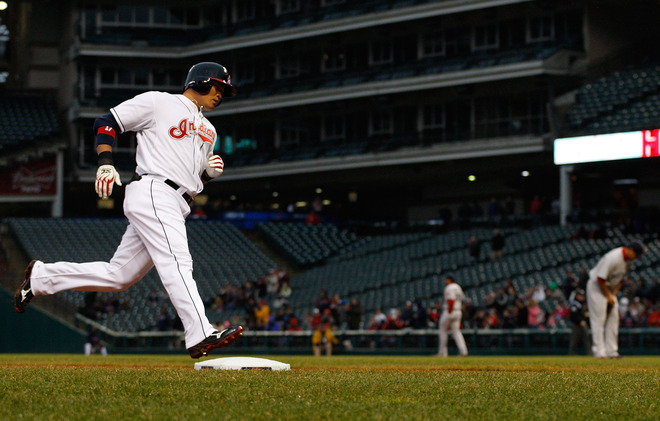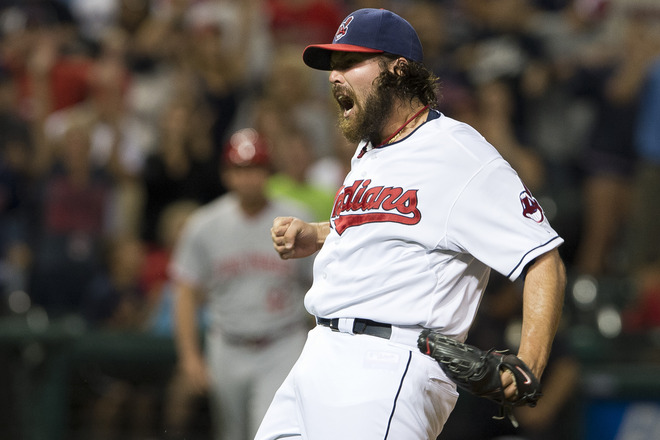 Indians Archive
Indians Archive  Deafening Silence From Indians At Trade Deadline
Deafening Silence From Indians At Trade Deadline
 With General Managers around the league scurrying to make last-minute acquisitions in a tough trade market, it was an eventful trade deadline day in Major League Baseball. None of the really big names, Justin Upton, Ryan Dempster, Matt Garza, or James Shields were traded, but names like Shane Victorino, Hunter Pence, and Paul Maholm did change teams. There were plenty of conversations, plenty of rumors, and several deals got done.
With General Managers around the league scurrying to make last-minute acquisitions in a tough trade market, it was an eventful trade deadline day in Major League Baseball. None of the really big names, Justin Upton, Ryan Dempster, Matt Garza, or James Shields were traded, but names like Shane Victorino, Hunter Pence, and Paul Maholm did change teams. There were plenty of conversations, plenty of rumors, and several deals got done.
The Indians got zero deals of consequence done (sorry, Lars Anderson, you are not a deal of consequence) and it was about the worst possible scenario for the present and future of the organization. Sitting five games back in the division and 5.5 games back in the wild card, being a buyer wasn’t really part of the equation. The Indians could have been buyers and manufactured a little bit of excitement for the stretch run, but between adding another salary and the cost of prospects, the return on investment wasn’t nearly good enough. The asking price on players who could have helped the Indians at positions of need was entirely too high for the team to mortgage parts of the future for a team that needs close to a miracle to make the playoffs this season.
That left the Indians with two options – stand pat or sell. The idea of standing pat made very little sense because the roster, as it’s currently constructed, is probably not good enough to propel the Indians past the White Sox and Tigers in 2013. Not only are the Indians not good enough with the current roster, the White Sox and Tigers will likely be active in free agency, again, and improve their ballclub while the Indians will get second-tier players and scraps. If the plan is to get things done in free agency and offseason trade negotiations, then standing pat is a fine idea. Given that the Indians rarely get heavily involved in free agency and almost never make offseason impact trades, it’s hard to believe that’s part of the plan.
Seemingly, the most beneficial option would have been to sell. In a low supply, high demand market, the Indians had several players who held quite a bit of value. It would have set the Indians back for 2013 and probably 2014 as well, but trading current big league players to replenish the farm system has always been one of the ways that the Indians compete. In baseball’s free market economic system, small and mid-market teams are required to build through the draft and maximize their assets to have a strong minor league system. The Indians minor league system is not good, with many scouts and scribes putting it in the bottom ten, sometimes bottom five, of the 30 MLB organizations.
Reportedly, there were varying levels of interest in Shin-Soo Choo, Chris Perez, and Justin Masterson. There were likely other players being discussed as well, but those were the only headline-grabbing names that the Indians had available. To a degree, the Indians were hesitant to trade these players because they are fan favorites and any time a team goes into a rebuild, or even partial rebuild, the fan base erupts in cynicism, pessimism, and, eventually, apathy.
Of the three, the most value probably belonged to Choo. Choo has been ridiculously consistent as a player, except for his 2011 season which was marred by off-field issues and freak injuries. Being thrust into the leadoff spot this season gave Choo even more value because he had a track record of being a productive run producer in the middle of the order and now has a track record of being a good leadoff hitter with power. He was practically unrivaled in the market, except for maybe Justin Upton. Maybe Hunter Pence was in the same ballpark, but Choo has a much higher career on-base percentage, something that executives fawn over in today’s player evaluations.
Not only did Choo have value to teams in the hunt, he had immense value to the Indians. With Scott Boras as his agent and a salary projected to be around $8M in his final year of arbitration, Choo will not be a Cleveland Indian in 2014. His price tag will be entirely too high and he has already made it clear that he wants to be part of a winning team. Suffice to say, with the Indians and their recurring “three-to-five year window of opportunity”, Cleveland is not an option for Choo and Boras.
The best course of action, no matter how unpopular, no matter what message it sent for 2013, was to trade Shin-Soo Choo for the best package available. Instead of being able to take advantage of the value of having Choo for a year and a few months as opposed to trading him in 2013, the Indians opted to keep him and hope for the best in 2013. He would have commanded a nice return of prospects, prospects that could have helped to replenish the farm system or possibly even made an impact as a September call-up.
We will never know for certain what the Indians were offered for Choo and none of us have any idea about these prospects and how well they project except for what “experts” tell us. What we do know is that Choo will not be here after the 2013 season, if he’s even here that long. The new CBA will limit the compensation that teams get for losing players to free agency, so the return for keeping Choo and taking compensation will not be as good as it could have been in years past. In knowing that, there should have been even more desperation to trade Choo.
 How about Chris Perez? One of the recurring themes of the 2012 MLB Trading Season was to enhance the bullpen. Several teams made moves to get bullpen help because baseball is such a specialized game. Late inning matchups are played by every manager and managers can never have enough bullpen arms at their disposal. Perez has been a top five closer in baseball this season, but, closers have a very high turnover and injury rate.
How about Chris Perez? One of the recurring themes of the 2012 MLB Trading Season was to enhance the bullpen. Several teams made moves to get bullpen help because baseball is such a specialized game. Late inning matchups are played by every manager and managers can never have enough bullpen arms at their disposal. Perez has been a top five closer in baseball this season, but, closers have a very high turnover and injury rate.
With Vinnie Pestano as a closer-in-waiting, the Indians surely could have picked up a couple highly-touted prospects for Perez, or at least one highly-touted prospect and a lottery ticket. Instead, they chose to keep a player who has proved to be disgruntled with the city and the ownership on several occasions this season. All of that while his arbitration price tag continues to go up and the chance of locking him into a long-term deal goes down.
When it comes to Justin Masterson, the picture isn’t as clear as Choo and Perez. Those two should have been moved to help in the future and before the Indians lose them for essentially nothing. With Masterson, a guy who the Indians would be selling low on because he’s not having the best season, he has top of the rotation potential, but his terrible splits against left handed hitters hurt his value, both to the Indians and to prospective trade partners. Certainly, the market for him wouldn’t have been as good nor would the expected return of prospects.
Not to mention, given how Josh Tomlin, Jeanmar Gomez, and Ubaldo Jimenez have performed this season, the future of the Indians rotation looks worse than ever. There is no top talent waiting in the wings in the minor leagues. Trading Masterson would have really set the team back, only because they would have had to demand a pitching prospect in return and, as the scouts and evaluators always say, TINSTAAPP (there is no such thing as a pitching prospect). There are too many injuries, too many examples of stuff not translating to the big league level, too many guys who bounce back and forth between the rotation and the bullpen, and everything in between.
Ultimately, the Indians failed more at this trade deadline than any of the trade deadlines in recent memory. Even with the Ubaldo Jimenez trade, which has not worked out how the Indians expected, they showed some backbone in taking a risk and were proactive in trying to improve the ballclub. The Indians are not contenders in this race and they’re lying to themselves if they believe that they are. Even if some quasi-miracle happens and they get into the playoffs, their rotation isn’t good enough to match up with the lineups that they’ll face.
The front office made a statement today that they believe they will contend in 2013. That will take some money from the Dolan family and some luck. The same holes the Indians began 2011 and 2012 with are the same holes that they appear to be beginning 2013 with, unless something drastically changes from October to April. The recipe for success makes sense for a team of the Indians financial standing. That said, you can’t expect the executive chef to make fine dining cuisine out of products purchased at Save-A-Lot or Aldi.
The only way that the Indians can obtain top talent is through trading their own talent or getting really lucky in the crapshoot that is the MLB Draft. Today might have been a missed opportunity. The worst thing the Indians could have done today is nothing. That’s exactly what they did.
- NBA Announces 2013-2014 Schedule
- Browns Ink Sharknado
- Sharknado A No-Show For Rookie Camp
- Trent Richardson Out Until Training Camp
- Browns Sign Brandon Jackson
- Carrasco Suspended Eight Games
- Browns Add to Wide Receiver Depth with David Nelson
- Browns Need to Learn from Past Draft Mistakes
- Browns Release Chris Gocong and Usama Young
- Browns Missing on Grimes Disappointing, But Not The End
The TCF Forums
- Chris Grant's first 3 drafts
Kingpin74 (Tuesday, January 21 2014 10:13 AM) - The 2014 Offseason Thread
googleeph2 (Tuesday, January 21 2014 9:36 AM) - 2015 Recruiting
furls (Tuesday, January 21 2014 6:57 AM) - Mike Brown
YahooFanChicago (Monday, January 20 2014 11:15 PM) - Movies coming out
HoodooMan (Monday, January 20 2014 9:34 PM) - 2014 Hoops Hockey Hijinx
jpd1224 (Monday, January 20 2014 4:44 PM) - 2014 Recruiting
jclvd_23 (Monday, January 20 2014 2:26 PM) - Wish List - #4 Pick
Hikohadon (Monday, January 20 2014 1:26 PM) - Official- Browns Coach Search/Rumors
OldDawg (Sunday, January 19 2014 6:48 PM) - #1 overall pick Anthony Bennett
TouchEmAllTime (Sunday, January 19 2014 1:28 PM)



